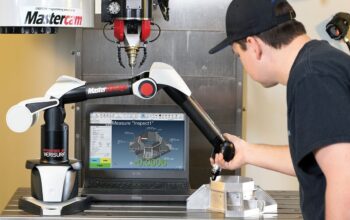Manufacturing companies that embrace the digital change embodied in Industry 4.0 will benefit from increased production efficiency and quicker project completion. For many years to come, these two together will fuel growth and prosperity.
A digital transformation is what? Although the idea is broad, one facet is the use of a virtual model of a manufacturing operation, process, or full factory to enhance and optimize actual processes. It requires modeling, assessing possibilities, and prognosticating results repeatedly rather than just once. Starting with manufacturing simulation, this digital transformation moves on to the construction and utilization of a digital twin before reaching a point where virtual commissioning is not only feasible but also a regular occurrence.
Long a pioneer in factory simulation, Visual Components has recently acquired Delfoi Robotics, a leader in offline robot programming, placing it in the driver’s seat for a true digital transition. Here’s how everything connects.
Simulation, Twins, and Virtual Commissioning
Manufacturers can simulate certain steps in their current or future production processes with the Visual Components software. It will demonstrate the viability of a layout or equipment configuration as well as any potential issues. When a production schedule is fed into this model, it outputs details like the anticipated output rate and the locations of bottlenecks.
This is made possible by a digital twin by connecting the digital model to the physical surroundings. A digital twin is “… the effortless integration of data between a physical and virtual machine in either direction,” according to a 2020 IEEE paper titled “Digital Twin: Enabling Technologies, Challenges, and Open Research” (Fuller, Fan, Day, and C. Barlow).
In actuality, data from the production system is continuously updated into the simulation model, and data flow back to it as necessary. Machine availability, yields, and running speeds are examples of real-world data. Revisions to feeds and speeds as well as new or updated motion control systems and robot programs could be included in the information returning to the actual world.
The idea of the digital shadow is linked. This is the case where the data flow is solely automated in the real world to model direction, as studied in the IEEE publication. Any modifications made to the model must be manually implemented in the real world.
For new production systems, machines, or lines, virtual commissioning is made possible through simulation and a digital twin. The twin speeds up construction and hardware integration at this point. PLC programming and offline robot programming are two places where this is done. With a digital twin, coding can be started sooner and evaluated prior to the physical system being finished in both situations. As a result, lead time and risk are decreased, and more alternative strategies can be evaluated.
The Concept-to-Reality-Workflow
How can a manufacturer put it all together if manufacturing simulation, digital twins, and virtual commissioning are phases in the digital transformation journey? An examination of the concept-to-reality workflow will demonstrate this.
In the past, there were often two or three phases to projects to deploy or reorganize industrial processes or equipment. A concept was created, after which it was designed and put into practice. Implementation almost always reveals design flaws, and fixing them typically entails higher costs, longer lead times, and settling for subpar performance.
Whether building new systems or improving those already in place, a business setting out on a digital transformation journey today will go through four phases:
- Concept design
- Simulation and analysis
- Virtual commissioning
- Execution
The adjacent figure shows how these phases interact. Here’s an explanation of each one.
- Concept Design: The engineers or project team are aware of the goals they have, but they still need to find a way to get there. Ideas are produced utilizing a simulation tool from Visual Components during the concept phase.
- Simulation and Analysis: After developing a model, numerous runs with various input conditions show the most likely results and point out areas for improvement. This iterative approach continues until a solution is found that provides the desired performance. The model is modified and utilized for additional feasibility studies.
- Virtual Commissioning: The digital twin arises from the simulation model when detailed design and physical construction begin. Links between the twin and real-world ensure that the two remain “synchronized,” and this documents the precise layout and configuration of the new gear. Virtual commissioning can now start. The digital twin is used to create and assess the control strategies and operational programs as the new line or equipment is put together. Sequences and time are evaluated, and the best solutions are created to meet the project’s goals.
- Execution: Programmes are now being moved to the actual system. Although some prove-out is still required to prevent collisions and ensure safety, there is no need for lengthy code writing because everything was completed concurrently with the physical build.
Benefits of This Workflow
Over the traditional methods of carrying out such a project, the aforementioned technique results in two significant advances.
First off, the project is finished much more quickly. This is essentially the outcome of developing and programming control software concurrently with physical construction as opposed to waiting until the system is ready to function. Finding and fixing bugs or other issues before software is installed into the system results in further time savings.
Second, the outcome is far more in line with the original design goals. This occurs because mistakes, errors, and overlooked information are found early when fixing them is simpler and less expensive. When things were done the old way, accepting less-than-expected performance sometimes made more sense because the expense of remedial or corrective work might be so high (therefore lowering project ROI). But for companies going through a digital transformation, issues are discovered and fixed online, where work can be done more quickly and cheaply.
The Visual Components – Delfoi Story: From Concept to Reality
20 years after its inception, Visual Components is still setting the standard for 3D manufacturing simulation. Visual Components software has evolved into a tool for feasibility studies (the second stage of the concept-to-reality workflow) and virtual commissioning, however, it is still used for modeling and optimizing manufacturing operations.
The execution was the missing component: Visual Components is not a company that programs robots. The purchase of Delfoi Robotics, however, has now closed that gap. Robotics offline programming software is created by Delfoi. Along with general-purpose, brand-neutral tools and modules, these solutions meet the unique requirements and difficulties of jobs frequently carried out by robots, like cutting, painting, and spot and arc welding.
This getting together marks the end of a fruitful and protracted partnership. Since 2008, Delfoi has been using the Visual Components software, and Visual Components has viewed Delfoi as a way to implement the robot motion patterns created during simulation. With the help of Delfoi, Visual Components can now assist manufacturers as they turn ideas into reality.
From Concepts to Execution
Through manufacturing simulation, Visual Components has been assisting companies for more than 20 years in understanding and enhancing their production processes. Visual Components has grown to support and enable the construction of digital twins and virtual commissioning in recent years as they’ve started on the digital transition of Industry 4.0.
Now that Delfoi Robotics has joined the Visual Components team, you have the chance to turn your ideas into reality.
Credits: Visual Components
Click on the following link Metrologically Speaking to read more such blogs about the Metrology Industry.









